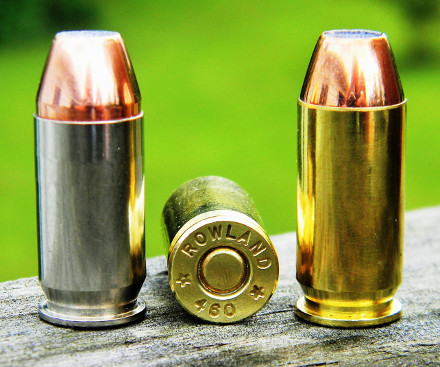
In the late 1990s, a gentleman named Johnny Rowland developed a slightly lengthened .45 ACP cartridge called the .460 Rowland. He wanted to create a more powerful .45 semi-auto handgun for self-defense and use against big game, which could still function in a slightly modified 1911. It could function through a 1911 because only the case was slightly longer- about 0.56”- but the overall length of a loaded round was still limited to 1.275”. Two things were necessary for this to work.
First, he simply seated the bullet deeper in the longer case to maintain the same overall length of the ACP. Second, he took the pressure up from 21,000 psi to 40,000 psi, and got the guns to operate without damage by using a heavier recoil spring, and added a compensator to the muzzle. The compensator effectively momentarily delays unlocking and slide rearward action until the much higher pressures have been dissipated, reducing the recoil velocity of the slide.
Nearly doubling the pressure resulted in some pretty enthusiastic claims. How about 1,560 fps with a 185 grain bullet from a 5” barrel, or around 1,350 from a 230 grain? Curious as to whether this was really possible, I contacted his company http://www.460rowland.com to see if they made a conversion for the Springfield XD .45 platform, which they did. Within a week, I received the new barrel and compensator, an assortment of their ammo, and a pack of properly headstamped .460 Rowland brass.
At the same time, I picked up a new XD .45 Tactical pistol- with the understanding from Springfield that they do not endorse so modifying any of their handguns- which is what I would expect a manufacturer to say. So noted I thought, and then performed the simple barrel change-out in just about a minute. The comp was secured in place by using a non-permanent thread locker, so I could take it off after testing.
I also upgraded the stock 18 lb. recoil spring to a Wolff 20 lb., as that’s the heaviest they make for the XD 45. Of course I assembled a good variety of suitable .451 bullets, both jacketed and cast. With the deluxe Lee 4-die .45 ACP set I already had, it was time to start assembling rounds, first making good use of the QuickLOAD ballistic program.
Chapter 1: Factory Ammunition Performance
Along with the barrel and compensator, I received five types of ammunition as loaded by the...
company. The first was identified as their-
Personal Carry load, using a 185 grain JHP bullet. It actually delivered 1,525 fps, good for 955 ft. lbs., and produced 5- shot groups at 25 yards at just over 2” with the open sights. For the velocity and energy level, I was very surprised at the modest recoil.
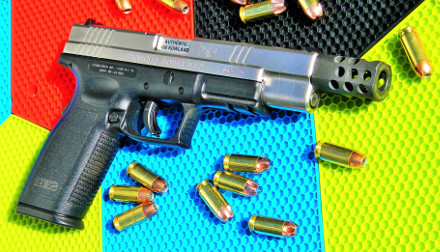
Next came a uniquely shaped 200 grain lead-free solid copper round called the Extreme Penetrator. Designed to give both deep penetration and still cause above average tissue disruption, the flutes in the nose serve to cause severe displacement from hydraulic pressure. It came in at 1,295 fps, producing 745 ft. lbs. Upon recovery of one of the bullets from a deep water tank, I was surprised to see that the barrel has a left hand twist, not right, as the solid copper bullet will not expand at handgun velocities, and its bearing surface displayed the twist.
The powerful Duty Round was next, featuring a 230 grain JHP, good for 1,380 fps and 972 ft. lbs. I was told this was developed for military/law enforcement as a load that will give complete torso penetration at most any angle.
The last two loads were meant for hunting or defense against large dangerous game such as boars or bears. The first is called the Magnum JHP load featuring a Hornady XTP MAG of heavier construction than traditional .45 ACP expanding bullets.
Surprisingly, it achieved their claims, delivering a 240 grain JHP, at 1,352 fps from the 5” barrel of my XD, producing 974 ft. lbs.! It expanded in water enough to produce a very aggressive frontal area of 0.66” diameter and held on to 239 of the original 240 grains. Approaching or exceeding .44 Magnum performance, it really was not at all that unpleasant to shoot. How can that be?
Just as the 10mm Auto can approach the speed and power of the .41 Magnum, so does the .357 SIG rival the .357 Magnum, or the .308 Winchester mirrors the larger .30-06 with lighter bullets. By using smaller charges of a faster burning powder, note that ballistically a smaller cartridge can approach...
a larger case in performance using around 20% less powder.
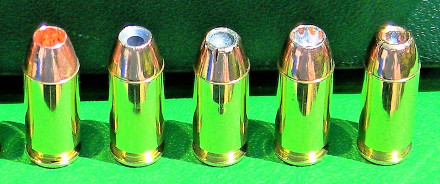
A full-power 10mm is far easier to shoot- as far as recoil, blast and flash- than the .41 Magnum. The same relationship exists with the .460 Rowland. I found it to be much more pleasant to shoot than equal power .44 Magnum loads, burning much greater charges of slow burning ball powders.
Tested last was their Large & Dangerous Game load, using a 255 grain hard cast round nose, flat point (RNFP). I chronographed this round at a respectable 1,154 fps, good for 754 ft. lbs., and grouping just under 2”, when I was having a good day at the range. So far I was very impressed. Also keep in mind that the XD carries 13 rounds in the magazine, while a revolver only holds six.
Chapter 2: Bullets and Loading Considerations
From Barnes, I obtain their TAC-XP 160 and 185 grain solid copper hollow points. Hornady provided their XTPs in 185, 200 and 230 grains. The 240 grain XTP MAG was also requested, as I had my doubts about standard .451 ACP bullets holding together well at .460 Rowland speeds. Nosler sent me some of their 185 grain Custom Competition JHPs, but at the time, none of their 230s were available. I also obtained Speer Gold Dots in 185, 200 and 230 grains. I did try some of their 250 Gold Dots meant for the .45 Long Colt, but the broad, soft nose would not feed from the magazine.
Cast bullets that were tested included a 225 grain Truncated Flat Point (TFP), a 250 grain Round Nose, Flat Point (RNFP), and last, a Cast Performance Bullet 265 grain Wide Flat Nose, Gas Checked (WFN GC) chosen for the huge flat point for maximum shock on boars. The 225’s meplat (the flat on the end of the nose) measures less than a quarter inch with rounded edges. The 250 RNFP is right at 0.24” wide, but also has rounded edges. But the 265 is almost 3/8ths inch wide at the nose and has a sharp edge. It fed fine with every load, but it had to be seated deeper at 1.210” due to the full ogive contacting the rifling if seated longer.
QuickLOAD was used to determine the top loads. Factory specs specify 40,000 psi as...
the maximum, but I limited my rounds to 38,000; some loads with slow powders were below that. Powders coming out as potentially giving the highest speeds included: Hodgdon’s CFE Pistol, Longshot, Universal, and HS-6. From Alliant- Power Pistol, Unique, Herco and Blue Dot were tested. I had limited access to Vihtavuori, but I tried their 3N37 and Tin Star powders.
All loads used Winchester large pistol primers and were loaded using a deluxe Lee 4-die set. I especially like the 4th die which uses a carbide ring to size the outside of a loaded round to just under maximum specs. This ensures smooth feeding and chambering. While this was the first time I ever used them, I’ll be replacing many of my handgun die sets with the Lee 4-die sets because of this benefit.
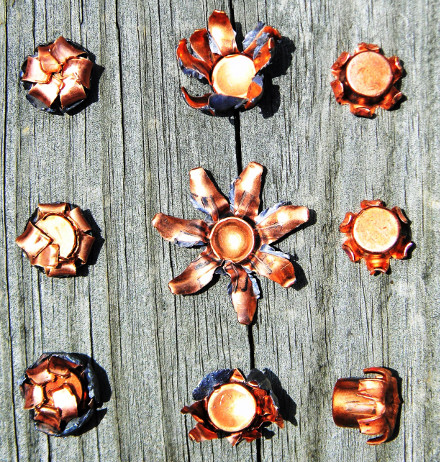
All handloads were seated to 1.248” OAL, except the blunt 265 WFN GC cast bullet, which had to be seated to 1.210”, feeding fine at this length with all loads. The top three powders, for speed with each bullet, were shot for accuracy with the open fixed sights at 25 yards from sandbags. As the bullets are leaving the barrel faster (sooner) than an ACP round, they shoot around 3.5” lower at that distance, as they’re out of the rising barrel sooner, when it’s still pointed initially lower. You’d need to install a taller rear sight, or better still, adjustable sights on your gun, to have point-of-aim impacts.
Chapter 3: Handloads Performance
The long-for-weight solid copper Barnes bullets with their huge hollow cavities and limited case capacity, still hit very good speeds, and expanded well like they always do, holding on to 100% of their weight. 11.5 grains of Power Pistol drove the 160 TAC-XP to 1,463 fps, for 760 ft. lbs. The longer 185 Barnes hit 1,227 fps over CFE Pistol, expanding to 0.63” 100% weight retention.
Power Pistol drove the 185 Hornady XTP to 1,574, but Longshot at 1,472 was slightly more accurate. This bullet expanded nicely to 0.71” and held on to 89% of its weight. Nosler’s 185 Custom Competition loved Power Pistol, reaching 1,498, with a best group of just under 2”- amazing for a fixed sight gun at 25 yards. The Rowland...
factory Personal Carry round hit 1,525 fps, and also was very accurate. For the 185 Speer Gold Dot, Hodgdon CFE Pistol delivered 1,473, expanded to just under one-inch, and retained 95%.
Both the 200 grain Hornady or Speer bullets were able to break 1,400 fps, for over 900 ft. lbs. Longshot, CFE Pistol and Power Pistol all produced the top speeds. The Hornady expanded to 0.67” and retained 85% of its weight. The Speer opened up like a six-pointed star to 1.4”, while retaining 199 grains in water expansion testing. In tissue, I doubt that the six “wings” would stay flared out like they did. Note that the faster 185 Speer also had six wings, but due to higher speed, they folded back towards the base of the bullet, reducing the frontal area, perhaps allowing for deeper penetration.
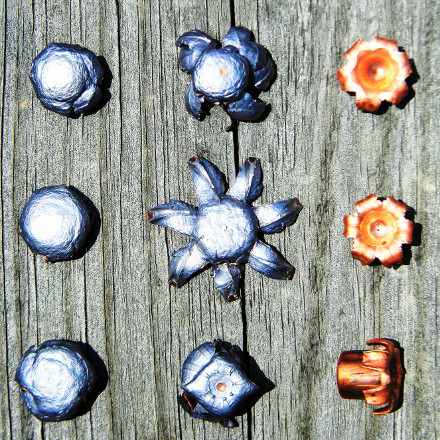
The 230 grain Hornady XTP produced 2.4 to 2.7” groups, as handloads or the factory Duty Round. The top three powders for speed- Power Pistol, Longshot or CFE Pistol were able to deliver 1,230 to 1,260 fps. How the factory reached 1,380, at 972 ft. lbs., is a mystery to me. None of the powders in the QuickLOAD database could deliver anywhere near that speed at maximum pressures. The huge, hollow cavity of the Speer 230 Gold Dot resulted in blowing the wings off the nose, but the base still retained 80% of its weight and had a 0.71”expanded frontal diameter.
The jacketed bullet that gives real purpose to the .460 Rowland is the 240 grain Hornady XTP MAG, as it was designed to function well beyond .45 ACP velocities. All previously tested lead cored, jacketed bullets were designed to open up adequately at normal, sedate ACP speeds. Full-power loads in the .460 are pushing them well beyond that. Note that the solid copper Barnes bullets can take all you can give them in a handgun, it's just that there are limits as to how deep a 160 or 185 can penetrate in tissue and bone. Only testing in the field or in ballistic gel would give an indication of their hunting potential. Fully adequate for deer, but how much larger game than that would have to be determined.
The 240 Hornady was very accurate over Power Pistol at 1,170 fps; or as the factory Magnum...
JHP load at 1,352. I don’t know how that speed was achieved, but at over 970 ft. lbs., it’s pretty amazing from a gun that used to fire the .45 ACP. Note that the extractor in the frame will allow you to also fire standard .45 ACP rounds in the .460 Rowland, as it keeps the case rearward against the breech face.
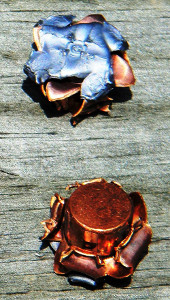
The XTP MAG expanded nicely to 0.79”, and retained virtually 100% of its weight, at 239 grains. My loads under this bullet used only 10 to 12 grains of powder- Power Pistol, CFE Pistol or Blue Dot- producing nowhere near the recoil, blast and muzzle flash of a .44 Magnum, which burns 20+ grains of slow ball powder. This is the first jacketed round I would feel comfortable carrying if confronting boars or bears with the .460 Rowland.
Cast bullets, with their lower cost, proved to be a viable option for the .460. The 225 cast TFP bullet was capable of being pushed to between 1,200 to 1,300 fps with the tested powders. Inexpensive for practice, the three powders tested for accuracy all grouped around 3”. With its relatively small flat point, it would not deliver much shock or trauma on boars. The Large & Dangerous Game factory load featuring a 255 grain RNFP hard cast bullet was very accurate at under 2”, producing 1,154 fps, and just over 750 ft. lbs.
My handloads using a similar 250 grain cast bullet of the same profile did not shoot as well, so more testing would be in order. Besides the 240 Hornady XTP MAG bullet, if carrying the .460 for defense against boars, the 265 grain WFNGC cast bullet with its over 3/8ths inch diameter flat point and sharp edges would be my choice. Around only 8 grains of Hodgdon Longshot or Alliant Power Pistol makes it fairly pleasant to shoot, drove it to around 1,050 fps, and both were good for around 650 ft. lbs. I also tried a traditional 255 grain cast semi-wadcutter, Keith-type bullet, but neither moderate nor full-power loads would feed from the magazine, jamming nose down below the feed ramp.
...
Chapter 4: Summary
Click to LOAD DATA SHEET
As the 9mm, .40 or standard .45 ACP are fully adequate for personal defense, any of the preceding jacketed rounds could be viewed as more than necessary for that task. Also coming to mind is that all .45 caliber bullets, designed for the much slower speed ACP, can readily open at its sedate velocities. While very fun and impressive to shoot water-filled gallon milk jugs with a 185 at 1,500 fps from the Roland, the bullets at that speed most likely will perform like a varmint bullet instead of a personal defense round, but for sure, still wreck the bad guy’s day.
So while the .460 Rowland is a blast to shoot with traditional ACP bullets, if you desire to carry a powerful semi-auto for hunting deer, wild pigs or black bears, the two factory heaviest weight loads… or handloads featuring a 240 Hornady XTP MAG, or a heavy flat point cast bullet is probably the way to go.